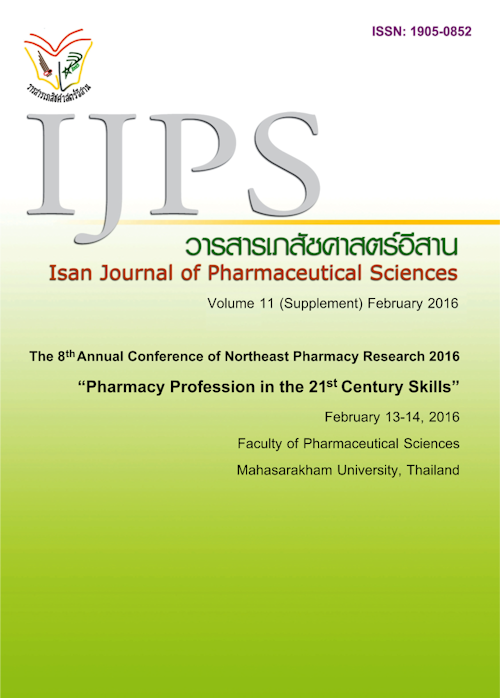An approach for determining the accelerated stability during the optimization of ellagic acid loaded transfersomes using the computer program
Main Article Content
Abstract
Introduction: In the development of pharmaceutical products, the objective of the formulation
optimization is to design and develop the proper dosage form that results in higher efficacy, safety and
stability. The formulation efficacy and safety can be assessed during the optimization process. The
evaluations for the formulation efficacy and safety saved time more than the formulation stability study. The
stability evaluation takes a lot of time for the long term stability study, so several researchers have chosen
the accelerated stability instead. However, at least 2-3 months were spent for the accelerated stability
evaluation. The objective of this study was to minimize the time and measurement samples for determining
the accelerated stability during the optimization of ellagic acid loaded transfersomes using the computer
program. Methods: Ten model formulations of transfersomes consisting of a constant percentage of
phosphatidylcholine, ellagic acid and various molar percentages of cholesterol and oleic acid from 0-
90%mol. The transfersome formulations were experimentally prepared and investigated. To evaluate the
stability, all transfersome formulations were kept in the stability chamber at 45C for 12 h and the
refrigerator at 4C for 12 h, for3 cycles. The sample was collected and measured through the
physicochemical characteristics, e.g. vesicle size, polydispersity index (PDI), surface charge and entrapment
efficiency. The Design Expert® was applied for determining the accelerated stability during the formulation
optimization. Results: The results suggested that the computer program was a powerful methodfor
estimating the stability of the formulation during the optimization process. Moreover, the Design Expert®
obviously showed the relationship between the formulation components and the formulation stability.
Conclusion: The utilization of the computer program in this study was succeeded in showing the feasibility
of the approach for determining the accelerated stability during the formulation optimization with the
minimization of time and measurement samples.
Article Details
In the case that some parts are used by others The author must Confirm that obtaining permission to use some of the original authors. And must attach evidence That the permission has been included
References
Briuglia ML, Rotella C, McFarlane A, Lamprou DA, Influence of cholesterol on liposome stability and on in vitro drug release. Drug delivery and translational research 2015; 5(3): 231-242.
Doltchinkova V, Nikolov R, Unsaturated fatty acids induced changes in surface charge density and light-scattering in pea thylakolid. Bulg J Plant Physiol 1997 23(1-2): 3-11.
Duangjit S, Mehr LM, Kumpugdee-Vollrath M, Ngawhirunpat T, Role of simplex lattice statistical design in the formulation and optimization of microemulsions for transdermal delivery. Biological & pharmaceutical bulletin 2014; 37(12): 1948-1957.
Duangjit S, Obata Y, Sano H, Kikuchi S, Onuki Y, Opanasopit P, et al., Menthosomes, novel ultradeformable vesicles for transdermal drug delivery: optimization and characterization. Biological & pharmaceutical bulletin 2012; 35(10): 1720-1728.
Duangjit S, Opanasopit P, Rojanarata T, Ngawhirunpat T, Characterization and in vitro skin permeation of meloxicamloaded liposomes versus transfersomes. Journal of drug delivery 2011; 2011: 418316.
Duangjit S, Opanasopit P, Rojarata T, Ngawhirunpat T, Physicochemical stability of meloxicam loaded vesicle formulation: effect of cholesterol. IJPS 2014; 9: 173.
Elsayed MM, Abdallah OY, Naggar VF, Khalafallah NM, Lipid vesicles for skin delivery of drugs: reviewing three decades of research. International journal of pharmaceutics 2007; 332(1-2): 1-16.
Junyaprasert VB, Teeranachaideekul V, Supaperm T, Effect of Charged and Non-ionic Membrane Additives on Physicochemical Properties and Stability of Niosomes. AAPS PharmSciTech 2008; 9(3): 851-859.
Kikuchi S, Takayama K, Multivariate statistical approach to optimizing sustainedrelease tablet formulations containing diltiazem hydrochloride as a model highly water-soluble drug. International journal of pharmaceutics 2010; 386(1-2): 149-155.
Nishikawa M, Onuki Y, Isowa K, Takayama K, Formulation optimization of an indomethacin-containing photocrosslinked polyacrylic acid hydrogel as an anti-inflammatory patch. AAPS PharmSciTech 2008; 9(3): 1038-1045.
Nishikawa M, Onuki Y, Okuno Y, Takayama K, Impact of the state of water on the dispersion stability of a skin cream formulation elucidated by magnetic resonance techniques. Chemical & pharmaceutical bulletin 2011; 59(3): 332-337.
Raffy S, Teissié J, Control of Lipid Membrane Stability by Cholesterol Content. Biophys J 1999; 76(4): 2072-2080.
Sulkowski WW, Pentak D, Nowak K, Sułkowska A, The influence of temperature, cholesterol content and pH on liposome stability. J Mol Struct 2005; 744–747: 737-747.
Verma DD, Verma S, Blume G, Fahr A, Particle size of liposomes influences dermal delivery of substances into skin. International journal of pharmaceutics 2003; 258(1-2): 141-151.
Vernotte C, Solis C, Moya I, Maison B, Briantais J-M, Arrio B, et al., Multiple effects of linolenic acid addition to pea thylakoids. Biochim Biophys 1983; 725(2): 376-383.
Williams AC, Barry BW, Penetration enhancers. Adv Drug Deliv Rev 2004; 56(5): 603-618.
Yordanov G, Bedzhova Z, Dushkin C, The effect of preparation method on the size distribution of poly(butylcyaoacrylaye) nanoperticles loaded with chlorambucil. Nanosci Nanotechnol 2010; 10: 162-165.
Yu LX, Pharmaceutical quality by design: product and process development, understanding, and control. Pharmaceutical research 2008; 25(4): 781-791.


